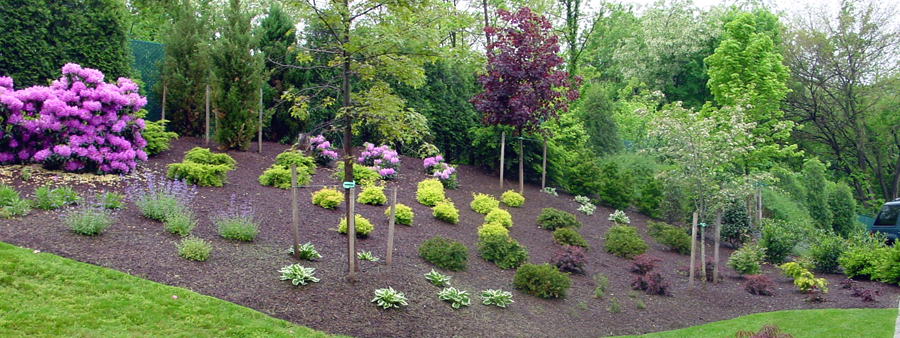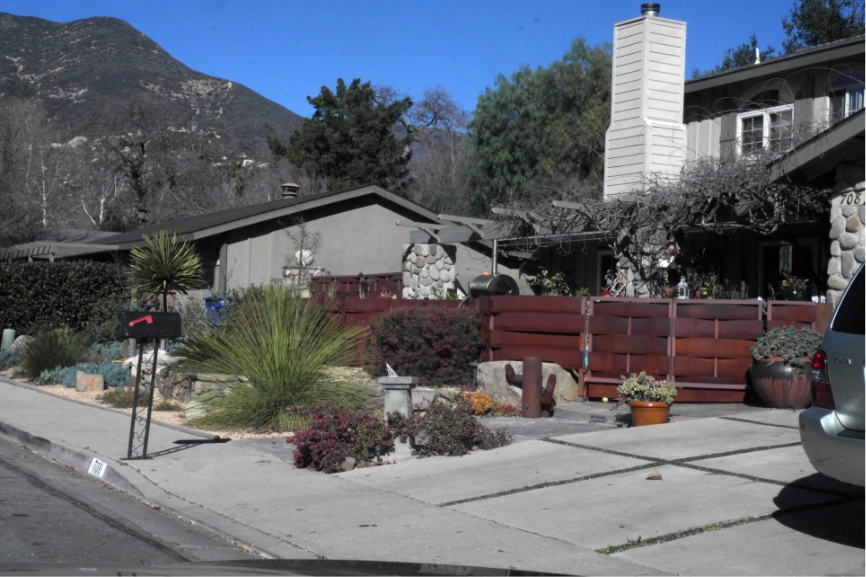The word “sustainable” gained new life over the last few decades as the concepts of sustainable agriculture and now sustainable landscapes were developed. But what actually are “sustainable” landscapes? This is not something that is easily defined, so I offer my own ideas on the subject here. We can think about this and be thoughtful about landscapes and garden choices as we grow, plant, and maintain landscapes at home and in public spaces.

A sustainable landscape provides benefits
If we start with soil, and nothing growing in it, we can move forward adding landscape elements and benefits begin to emerge. Plants provide habitat for animals including arthropods. As the diversity of plants in a landscape increases, so does the diversity of visitors that use that vegetation. The sculpting of the land may create water catchment areas that help sustain soil moisture. Hardscape (walls, patios, water features and rocks) may create visual focus points. Plants provide many benefits such as sound absorption, dust collection, shade, food, and of course can also be aesthetic. The most sustainable landscape provides its benefits with a minimum input of water, fertilizer and labor to maintain.

A sustainable landscape is appealing
Why expend energy or spend money maintaining an ugly landscape? Landscapes in order to be sustained, must appeal in some way to those that use them. In some cases plants in landscapes are adapted to their environment and require little applied water, pruning or other maintenance in order to survive and provide benefits.
Sometimes addition of color to a landscape will help its visual appeal. Surveys of gardeners suggest that colorful landscape are more appealing than those that are only green in color.
Points of interest within a landscape make it appealing. Also, hiding the landscape with gates, shrubs or walls provides intrigue and beckons you forward to explore the unseen parts. While mass plantings of the same plant material can be stunning so can specimen trees or other plants that are strategically placed for high impact. Landscape art either man made or nature made (rocks and logs) can be become the focus of a landscape making it appealing.

A sustainable landscape often contains trees
Trees are the workhorse of landscapes. They provide shade and thus reduce energy costs in landscapes and they are extremely visually aesthetic. Trees are very important for birds, insects, squirrels, and other animals. Trees remove carbon from the atmosphere and feed the soil food web with the captured carbon. Trees help increase the capture of rainfall and the water infiltration rate of soils. While trees do require maintenance (which can be expensive), maintenance costs can be reduced by proper selection, pruning and placement in the landscape. Trees also have proven health both (physical and psychological) benefits for people who live or reside near them.


A sustainable landscape should not consume excessive amounts of energy
The traditional landscapes I grew up with included lawns in the front and rear of residences. This of course required frequent mowing, often with gasoline powered equipment. Shrubs were planted that required shearing with electric or gas powered hedge clippers. Since mulches were never much used, fertilizers (derived from petroleum) were used to push growth which was clipped and hauled (using petroleum to power the trucks) to a landfill. As you can imagine a lot of energy is utilized to maintain such landscaping. Much of the petroleum-based energy expenditure can be mitigated by using more mulch especially if it is produced on site, limiting the expanse of turfgrass to needed areas, and planting or utilizing adapted plant materials to the site and climate. Surround trees with tree chip based mulches, not turfgrass.


A sustainable landscape should be water efficient
For those of us in the west we continue to suffer multidecade droughts. Water use efficiency is necessary for our landscapes to be sustainable because water is expensive and limited. For those that have excess water landscapes need to manage the excess water well without suffering erosion or soil nutrient losses that compromise the landscaping.
Sustainable landscapes provide room for waste recycling
One problem with landscapes that don’t use mulch is that there is no place to recycle used plant clippings. If landscapes are fertilized and irrigated to produce lush growth that is then disposed of with a waste hauler, this is not sustainable. It is best if clippings can be resused as mulch under shrubs or in other out of sight mulched places.
Sustainable landscapes use adapted plants
Adapted plants are not necessarily native plants but plants that can live in the soils at the site with the amount of water that is available to them with a minimum of extra care, fertilizer, requirement of pruning or other inputs (pest management) to keep them looking good.
There are likely many other tenets of sustainable landscapes, but these are some of the key factors. The landscape should be adapted to the climate, provide huge benefits and require less maintenance and then it is, by all means and metrics, sustainable.

This is a good summary of the things to consider when planning a sustainable landscape which, for me, is a goal I’m still working to achieve … that and ‘low-maintenance’ as I grow older. In many ways, the 2 go hand-in-hand don’t they?
One small suggestion: I’d like to see the name of whoever has written each article at the top, just under the title. I always scroll to the bottom to find out before scrolling all the way back up to the top to begin reading.
The format of WordPress where we publish the blogs does not put author names at the top. We would need to make it part of the title and that is not something as a group we have decided to do. It is a good suggestion though. So hopefully we can talk about that when we meet next.
If lawns were cut with gas-powered motors when you were a kid, you are certainly younger than me. Our lawns (in the 1950s) almost always consisted of white clover and a number of different turf grasses, not to mention weeds. As kids, we had great fun picking various flowers out of the lawns. Kids today miss this great opportunity.
Great article. I feel like I learned a few things. Any more sustainability tips specifically in regards to vegetable gardens? I already use wood chip mulch and compost old plant material, but it feels like there could be more I could be doing to make my veg garden more sustainable.
I think sustainability of the vegetable garden is a good blog topic for one of our professors more knowledgeable of veg. production. One of my colleagues, former row crops extension agent (long retired) used to say he would put all the veg garden waste into a trench and keep filling it until it reached the endpoint then start planting over the top of it. To me this was very sustainable (as long as pathogens are being recycled such as Verticillium). The waste was used on site and the organic matter was maintained in the soil over time. The only green material leaves his garden was reprocessed by eating it…
I like the idea of reusing the garden waste, but this sounds like a potentially excessive amount of OM being added and possibly creating nutrient toxicities. I’d check your nutrient levels through a university soil test first to make sure you don’t create problems.